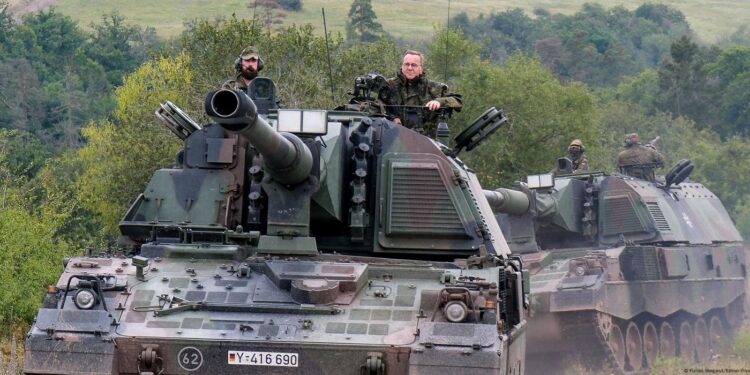Germany’s Ambitious Plan for a Leading EU Military by 2031: A Revolutionary Shift in European Defense
In a significant move that could redefine the landscape of European defense, Germany has announced its intention to establish the most formidable military force within the European Union by 2031. This strategic initiative marks a crucial transformation in Europe’s approach to security challenges, driven by escalating geopolitical tensions and an urgent need to reevaluate defense priorities. As EU member states face external threats and navigate complex transatlantic relationships, Germany’s plan may set new standards for collective military capabilities. By committing to bolster its armed forces and invest in advanced technologies, Berlin aims to play a pivotal role in enhancing regional stability and elevating the EU’s global standing. The implications of this ambition extend beyond Germany itself, potentially reshaping collaborative defense strategies across Europe and affecting NATO’s relationship with the EU. This article explores Germany’s motivations behind its defense strategy, assesses potential impacts on European security, and considers responses from key stakeholders both within and outside of the EU.
Germany’s Ambitious Plan for a Leading EU Military By 2031
Germany is making significant strides toward establishing a robust unified military presence within the European Union by 2031—a move seen as essential for enhancing collective security while reducing dependence on NATO frameworks. This initiative has gained momentum amid rising geopolitical tensions and shifting global power dynamics. As one of the foremost members of the EU, Germany is advocating for stronger defense collaboration aimed at revitalizing military capabilities while promoting joint operations among member states.
To realize these goals,German officials are outlining several strategic initiatives:
- Increased Investment: Boosting budget allocations dedicated to defense initiatives and also collaborative military research focused on advancing technological innovations.
- Cohesive Command Structures: Creating an integrated command hierarchy that enhances effective coordination among various EU forces.
- Joint Training Exercises: Implementing regular training programs designed to improve operational readiness and interoperability among troops from different member nations.
This proposed framework aims to foster a more resilient identity for European defense—enabling nations within the union to respond swiftly to emerging threats while asserting their strategic autonomy.
Strategic Considerations for Defense Alliances and Budget Planning
The ambition of creating Europe’s strongest military force by 2031 will heavily depend on forming strategic alliances that enhance collective defensive capabilities across member states. Collaborative efforts are expected not only to improve interoperability but also promote unity against emerging global challenges.Key factors influencing these alliances include:
- Cohesive Training Initiatives: Expanding joint training exercises ensures seamless operation between diverse forces during missions.
- Synchronized Resource Allocation: Streamlining budgets through shared procurement strategies can optimize financial resources across nations.
- Pioneering Technological Advancements: Encouraging cooperative development of advanced military technologies will help maintain competitive advantages in modern warfare scenarios.
Additionally, national budgets will likely undergo substantial revisions as countries reassess their expenditures amidst changing geopolitical landscapes. Germany’s proposed investments could influence overall discussions regarding contributions from other member states towards EU defense spending.Critical elements shaping this habitat include:
- Economic Factors: Balancing national fiscal responsibilities with enhanced readiness levels remains crucial .
- Political Consensus: Ensuring agreement among all members regarding effective fund allocation is vital for success .
- Evolving Security Threats: Adjusting budgets based on new threat assessments will be necessary moving forward .
Country Projected Defense Spending 2031 (in billion €) Primary Military Focus
<td
Germany
<td
70
Technological advancements alongside NATO commitments .<td
France
<td
60
Naval strength along with nuclear capabilities .<td
Italy
30
Cybersecurity measures coupled with joint initiatives across Europe .<td
Poland
20
Modernization efforts focused on land forces plus regional safety.Strategies For Enhanced European Defense Collaboration And Capability Improvement
Aiming towards establishing Europe’s most formidable army by 2031 necessitates fostering an environment rich in collaboration alongside innovation concerning defensive capacities . Prioritizing joint procurement programs can minimize redundancy whilst promoting economies-of-scale benefits . Additionally , investing heavily into research & development related next-gen technologies such as artificial intelligence & cyber defenses proves critical when maintaining competitiveness during contemporary conflicts .
A complete cooperation framework should encompass :
- Total Military Investment :( Committing towards meeting NATO guidelines requiring two percent GDP allocation would galvanize additional resources directed toward collective protection ) ;
- Simplified Command Structures :( Establish unified command levels facilitating multinational operations enhances response times & operational efficiency ) ;
- Tandem Training Programs:( Regularly scheduled exercises ensure seamless integration amongst various nation’s armed services during missions ) ;
- Adequate Intelligence Sharing:( Strengthening inter-agency collaborations improves situational awareness throughout all participating countries ) ;
Key Areas Proposal Conclusion: A New Era Awaits?
In conclusion , Germany ‘ s ambitious vision aiming at constructing Europe ‘ s strongest army before year-end twenty thirty-one has ignited considerable dialog throughout continent-wide circles .As it navigates through increasingly intricate geopolitical terrains characterized not only by heightened tensions but also economic hurdles along evolving security risks , Berlin ’ s dedication toward fortifying its own militaristic prowess stands poised potentially reshape entire E.U.’s defensive paradigms altogether.
The implications stemming from this undertaking resonate far beyond mere membership concerns; they touch upon sovereignty issues intertwined deeply rooted ancient contexts surrounding collective safety arrangements too! With eyes fixed firmly upon future developments ahead—stakeholders remain vigilant observing closely how effectively plans transition into actionable outcomes capable bolstering not just individual defenses but strengthening unity amongst all involved parties alike!
- Political Consensus: Ensuring agreement among all members regarding effective fund allocation is vital for success .
















